“`html
Capturing the World: Tips for Photographing Tourist Attractions
Travel photography is an art that combines the exploration of new places with the capture of their essence through a lens. Capturing tourist attractions in eye-catching ways can be a rewarding part of your travel experience. This guide delves into practical tips and techniques that will elevate your photography skills. Whether you’re wielding a smartphone or a high-end DSLR, understanding camera settings, exploring creative compositions, and timing your shots can make a significant difference. Dive into each section to discover insights, from making the most of the golden hour to creatively including people in your shots. Let’s unlock the secrets to not just capturing moments, but also living them fully.
Travel Photography Tips
1. Know How to Use Your Camera
Understanding your camera is the foundation of great photography. Whether you’re using a smartphone or a DSLR, familiarize yourself with its settings and capabilities. Take the time to practice using different modes, such as manual, aperture priority, and shutter priority, to have greater control over your shots. Each mode can serve unique purposes, ensuring you capture your vision precisely.
It’s equally important to learn about features like ISO, white balance, and autofocus. These functions allow you to adapt to various lighting conditions and subject types. Most cameras come with a detailed manual, and there are countless online tutorials available to help you master your camera. Remember, the better you know your device, the more you’ll be able to push its limits to capture stunning, creative images.
2. Rule of Thirds
The rule of thirds is a basic but effective composition technique that can enhance the visual appeal of your photographs. Imagine your image divided into nine equal segments by two vertical and two horizontal lines. Positioning your subject along these lines or at their intersections creates balance and interest.
This technique helps draw the viewer’s eyes towards the main elements of your photograph, creating a pleasing and professional appearance. It’s versatile and can be applied to landscapes, architectural shots, portraits, and more. Many cameras offer a grid overlay feature that can assist with adhering to the rule of thirds when composing your shots.
3. Do Your Research
Before visiting any tourist attraction, it’s helpful to conduct some research. Understanding the history and significance of a location can provide deeper insights and influence how you choose to capture it. Look for unique perspectives that distinguish your work from typical images of the site.
Also, consider learning about the best times to visit for optimal lighting and fewer crowds. Online resources, travel blogs, and social media can offer valuable tips from other photographers, helping you to plan your shoot effectively and uncovering hidden gems off the beaten path.
4. Book a Hotel with a Great View
Choosing accommodation with a stunning view can enhance your photography experience significantly. Waking up to a picturesque landscape or cityscape view can provide ample opportunities for beautiful shots without even leaving your room.
A good vantage point can offer perspectives that are not accessible from the ground level. Consider hotel options that boast rooftop terraces or rooms with balconies, allowing you to capture sunrise or sunset shots, and giving you more time to focus on composition and lighting.
5. Have You Heard of the “Golden Hour?”
The golden hour is a magical time for photography enthusiasts. It occurs shortly after sunrise or before sunset, providing a soft, warm golden light that enhances the colors and textures of your photos. This quality of light transforms ordinary scenes into extraordinary ones.
The golden hour is perfect for capturing landscapes, architectural wonders, and portraits with a natural glow. Plan your shoots around these times to take full advantage of the ethereal lighting, creating captivating and memorable images.
6. Bring a Tripod
A tripod is an essential tool for travel photography, especially in low-light conditions or when you want to experiment with long exposures. It provides stability for your camera, ensuring crisp, clear images every time.
Tripods are also invaluable for self-portraits or group shots, allowing you to be part of your travel memories without relying on strangers to take your picture. Lightweight, portable tripods can fit easily into your backpack, making them a worthwhile investment for any travel photographer.
7. Tell a Story with Your Photos
Photography is an art form that allows you to tell a story through visuals. Capture the essence and ambiance of a place by including elements that convey emotions and narratives. Whether it’s a bustling market scene, serene landscapes, or architectural marvels, your photos should reflect the unique character of the location.
Consider the details – colors, patterns, people, and activities that define the scene. By thinking like a storyteller, your photos will evoke feelings and transport viewers to that moment in time, making your work more engaging and meaningful.
8. Photographing People
Including people in your travel photos can add life and context to your shots. Candid shots of locals engaging in daily activities or fellow travelers experiencing the attraction can provide a sense of authenticity and relatability.
Before capturing someone’s image, be respectful and ask for permission where necessary. This is not only courteous but also offers an opportunity to interact and learn more about local culture. Engaging with your subjects can lead to more natural and genuine photographs.
9. Buy Something
Purchasing a small souvenir can inspire unique photography ideas and serve as a memorable prop. Items like postcards, trinkets, or local handicrafts can be creatively included in your shots to add personal touches and cultural elements.
Think of how these objects can complement your location photography. Perhaps a postcard from the attraction can be held in the foreground with the landmark in the background, creating a powerful visualization of your journey.
10. Wander Off the Main Tourist Trail
While well-known tourist attractions offer great photo opportunities, exploring off the beaten path can yield unique and unexpected images. Venture into lesser-known areas to capture scenes that many travelers might overlook.
These off-the-main-trail photos can depict everyday life and hidden gems, offering a different perspective on the destination. They often hold more personal value as they reflect experiences shared by fewer visitors, making your travel narrative distinct.
11. Dealing with Anxiety
Photography can be daunting, especially in busy tourist areas. If you feel overwhelmed, take a moment to breathe and assess your surroundings. Confidence builds with practice, so focus on the joy of taking photos rather than perfection.
Try engaging with other photographers or immersing in the moment to calm nerves. Remember, photography is a personal journey, and it’s okay to experiment and make mistakes as you improve your skills over time.
12. Don’t Forget to Live in the Moment
While capturing the perfect shot is rewarding, it’s essential to sometimes put the camera down and live in the moment. Appreciate the beauty and essence of your surroundings without the urge to document every detail.
Balance your time between photography and personal experiences. After all, the most cherished travel memories often come from moments where you simply enjoy the scene in front of you, unobstructed by the viewfinder.
Next Steps
| Tip | Description |
|---|---|
| Know How to Use Your Camera | Familiarize yourself with camera settings and modes for better control over your shots. |
| Rule of Thirds | Use this composition technique to enhance visual interest and balance in your photos. |
| Do Your Research | Learn about your destination to find unique perspectives and optimal shooting times. |
| Book a Hotel with a Great View | A hotel with a scenic view can offer convenient and stunning photographic opportunities. |
| Golden Hour | Shoot during this time for beautiful, natural lighting. |
| Bring a Tripod | Essential for stable, clear shots, especially in low-light conditions. |
| Tell a Story | Compose images that convey a narrative and reflect the atmosphere of the place. |
| Photographing People | Add depth and context to your shots by including candid captures of people. |
| Buy Something | Use local souvenirs as creative props in your photography. |
| Wander Off the Main Tourist Trail | Explore lesser-known paths for unique and less captured images. |
| Dealing with Anxiety | Relax and enjoy the process, focusing on improvement rather than perfection. |
| Live in the Moment | Balance taking photos with simply enjoying the travel experience. |
“`


